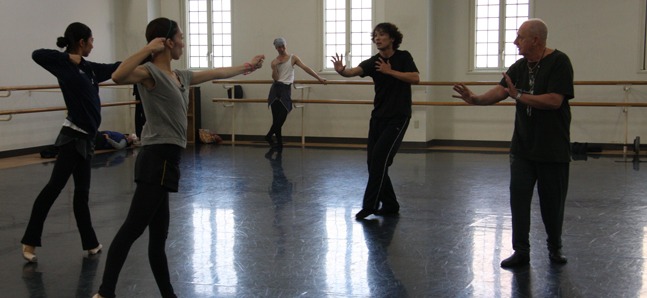Enchanted by ‘Sylvia’
Christopher Newton choreographs a classic for The Tokyo Ballet

Courtesy of The Tokyo Ballet/NBS
Posted: Thu Feb 25 2010
‘It’s the classic three-act ballet,’ says British choreographer Christopher Newton of ‘Sylvia’, an iconic ballet being staged as part of the Tokyo Ballet’s forty-fifth anniversary season. Visiting Tokyo for several weeks, Newton has been teaching and rehearsing with the company to impart his detailed knowledge of ‘Sylvia’ in its most iconic version.
A Leicestershire native, Newton received a scholarship to study at the Royal Ballet School, after which he joined the Royal Ballet in 1954. During his tenure as dancer, Newton worked closely with Sir Fredrick Ashton, one of the most significant choreographers of the twentieth century.
‘Sylvia’ is a story of love, capture and rescue steeped in Greek mythology. Popularised in the nineteenth century before falling out of favour, it was not until 1952 that Ashton’s revival– featuring the legendary Margot Fonteyn– brought ‘Sylvia’ back into the spotlight, eventually counting Newton among the dancers.
‘At the time the ballet was choreographed by Ashton, I was a student at the Royal Ballet School. The very first thing I ever did in this ballet was at the beginning at the third act, there are four trumpeters, that herald the beginning of the act, very simple stuff; and because there were no dancers to do it in the company, the students would do it.
‘When I joined the company, we went on a big tour of America, I think we were there for three months, and we did a lot of performances of ‘Sylvia’, and I got to know it very well. We did another tour there again in 1957, which was even longer, for six months. We went to every major city, and again we did ‘Sylvia’. It was one of these ballets that really got ingrained in my brain. You know, a young brain – at that time – remembers things,’ recalls Newton of his long relationship with the production.
Indeed, ‘Sylvia’ is one of the productions that Newton is most tied to as a choreographer. When asked about his relationship with the ballet after having danced it, worked on it with Ashton, and now carrying on Ashton’s legacy within his own choreographic vision, Newton makes the process seem quite natural. ‘I’ve sort of grown up with it, you know. It’s second nature to me. It’s one of those things I’ve never really questioned myself about. So many people have said to me over the years, “Oh, it’s such an obscure story,” but it’s never seemed that to me, somehow. It seems to me to make absolutely logical sense. It’s simplicity... no more complicated than Sleeping Beauty or Swan Lake, for me.
‘Sylvia’ also presents an opportunity for the dancers to actually get up and dance. So very often in the classics, like in Sleeping Beauty, there is very little for the men to do. It’s all the women...but this one, because he [Ashton] wrote it in the middle of the twentieth century, he wrote much more for men, much for the company in general.’
According to Newton, Ashton’s choreography–of both classic and modern works– allows for flexibility and innovation. He was constantly refining his approach to the ballet’s challenges, despite ‘Sylvia’ being dropped from company repertoire around 1965.
Then in the mid-’80s, Ashton and Newton (by then Ballet Master at the Royal Ballet) began work on one of Ashton’s other famous productions, ‘Ondine’. Its success prompted Ashton to reconsider staging ‘Sylvia’; however, he soon passed away. ‘In 2003, when Monica Mason took over as director of the company, she asked me if it was possible to be able to revive it,’ Newton explains of the first steps towards his acclaimed resurrection of Ashton’s choreography.
‘One of the things that we were able to do was to put a transformation scene into the end of act two, which brings us scenically into act three,’ he points out about the changes in choreography that he’s implemented based on his conversations and collaborations with Ashton. ‘And that allows us to do it in two acts [as the American Ballet Theatre did in 2004], though here it will be done in three. But that allowed us to re-work what we needed to re-work in it; make sort of major changes to act two.
‘What I did was to take basically Ashton’s choreography for act two and another designer – Peter Farmer – created a new set enabling the transformation into act three. We really adapted it for this new set, and how we wanted to carry the story into act three, so everyone seemed pleased and I guess I did the right thing! That’s how it came about…’ recounts Newton.
However, being a conduit for such priceless choreographic knowledge doesn’t come without challenges. ‘The biggest challenge is to maintain the Ashton style, which is a very soft, fluid style. It does also lend to bravura, but his style is very plastique, soft and flowing. And the tendency nowadays for dancers nowadays is to concentrate so much on the technical aspect of the dance that they forget about interpretation, and storytelling.’ Newton cites that indeed, one of his major challenges when working on ‘Sylvia’ is to get ‘storytelling through the dance itself’ out of the dancers.
Newton is not a newcomer to Japan and local ballet audiences, having worked here before. ‘The reception [with the Royal Ballet] has always been very good, but this is the first time I am working with a Japanese ballet company. Japanese audiences have seen [‘Sylvia’] danced here before by the Royal Ballet, so it may not be unfamiliar to them,’ he says of the experience so far. ‘Japanese ballet audiences are very receptive.’
When asked why ‘Sylvia’ has an enduring quality that draws such enormous interest, Newton answers simply, ‘It has universal appeal. It’s one of those ballets that you can go to and get lost in.’
‘Sylvia’ will be performed by the Tokyo Ballet, as choreographed by Christopher Newton from Fri Feb 26 and Sun Feb 28.
Related articles:
・Galleries to watch
5 must-see, break-out galleries in Tokyo
・A choir of complaints in Tokyo
Duo bring relief with a choir of complaints for MAM Project 10
・Nick Walker paints Tokyo red
Bristol artist gets out his paints and tells Time Out Tokyo about his art
Tweets
- About Us |
- Work for Time Out |
- Send us info |
- Advertising |
- Mobile edition |
- Terms & Conditions |
- Privacy policy |
- Contact Us
Copyright © 2014 Time Out Tokyo












Add your comment